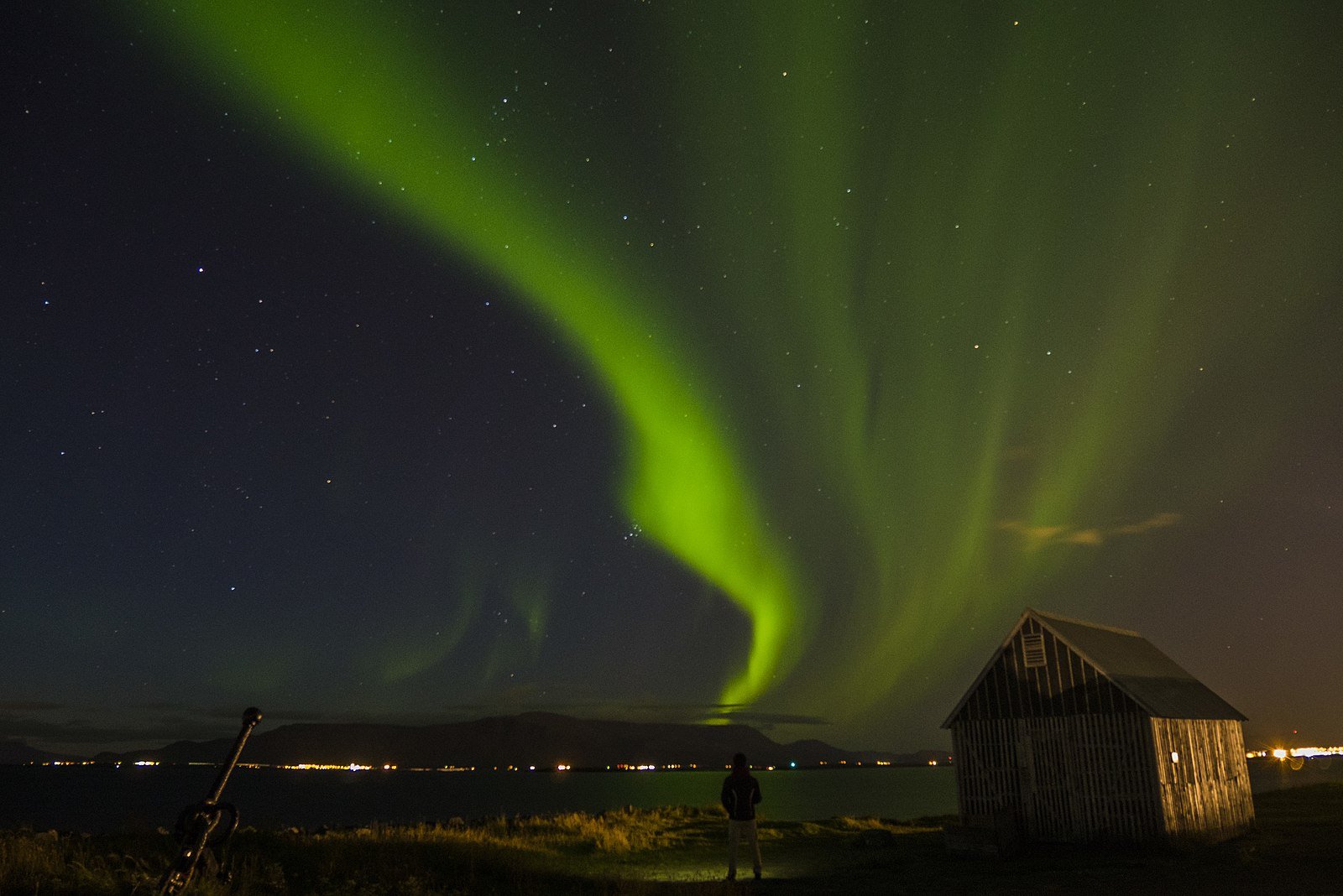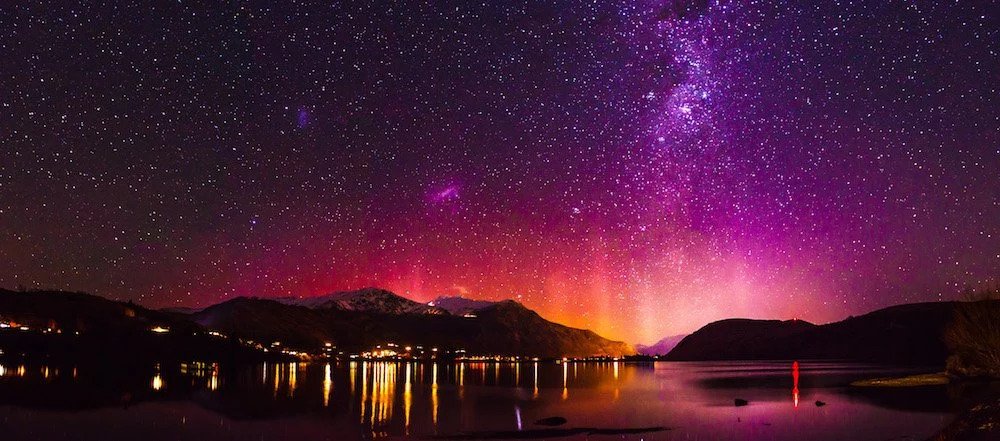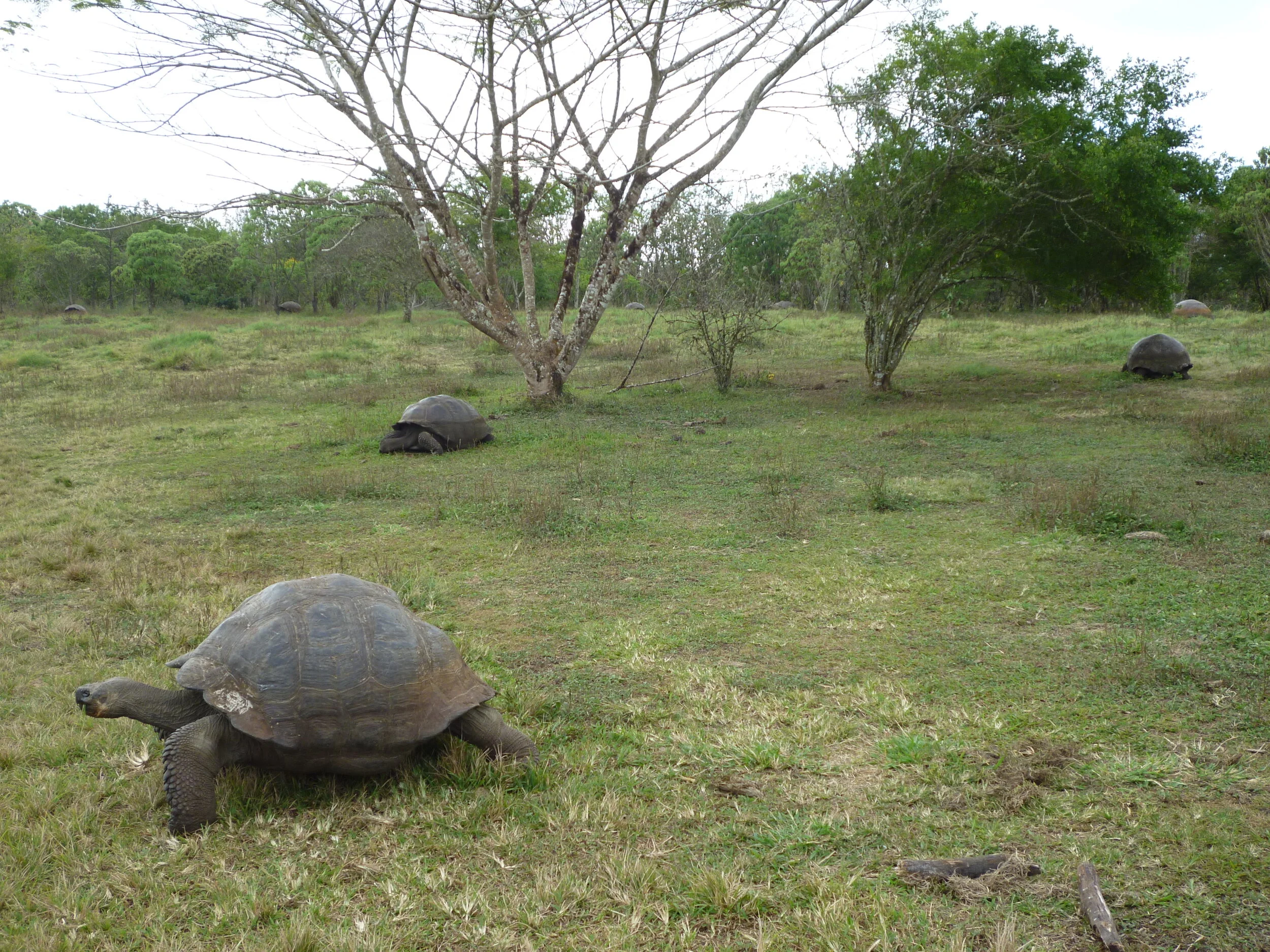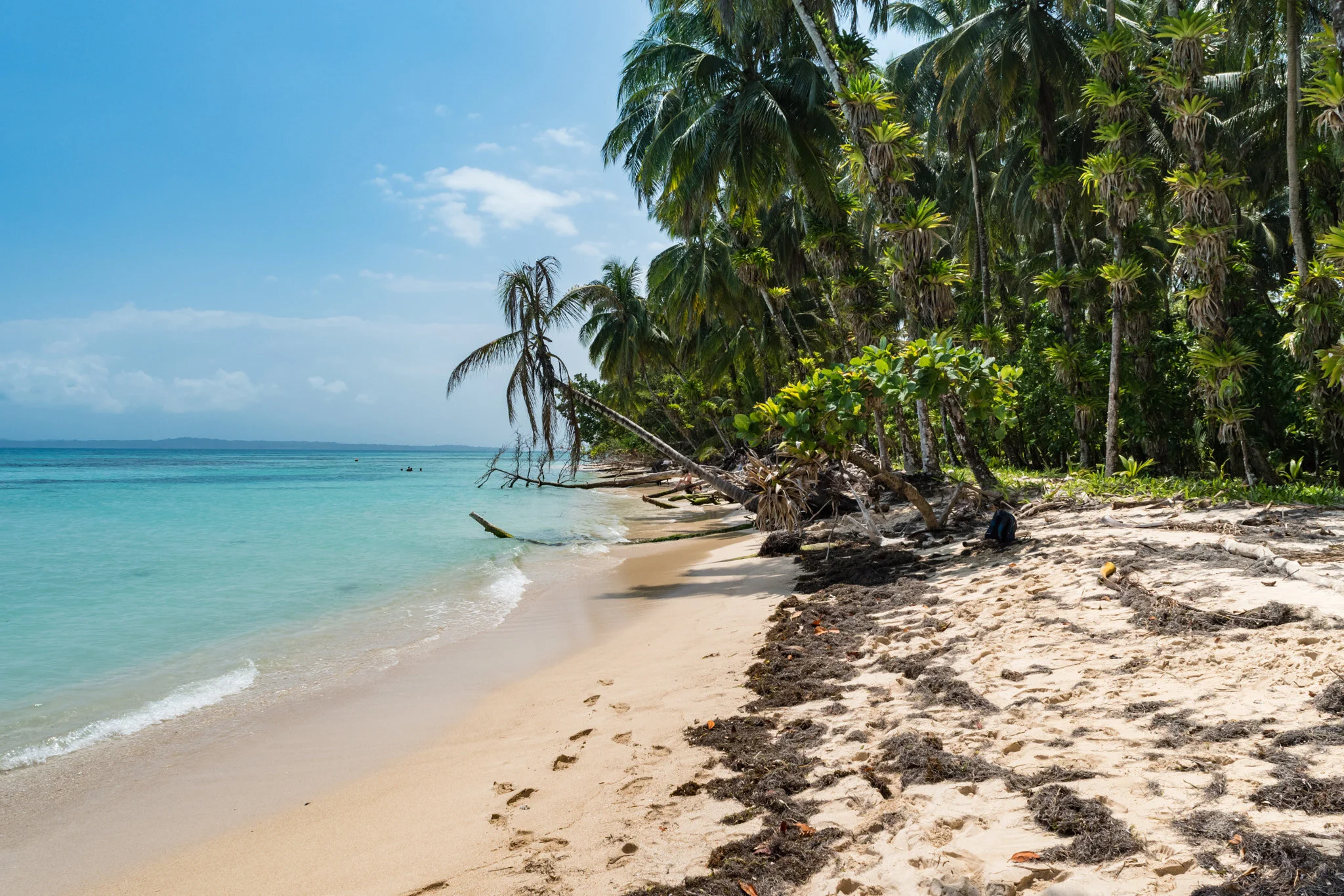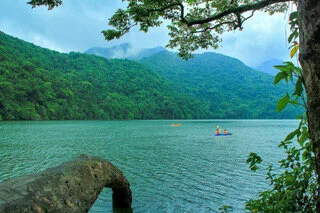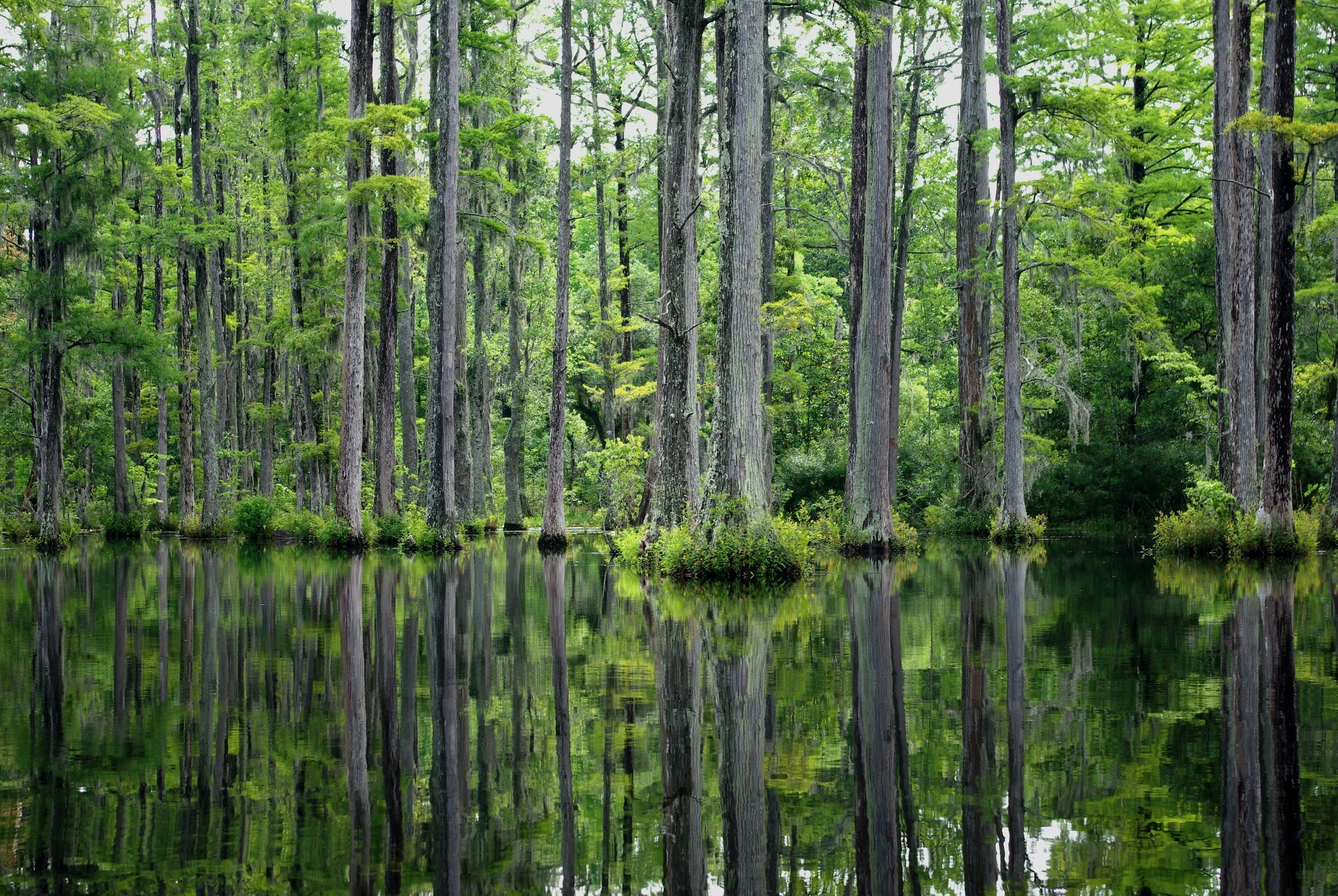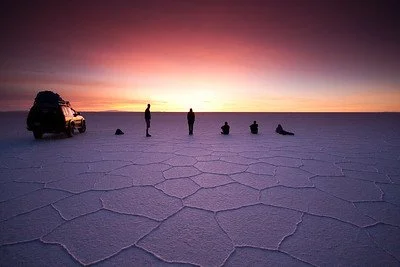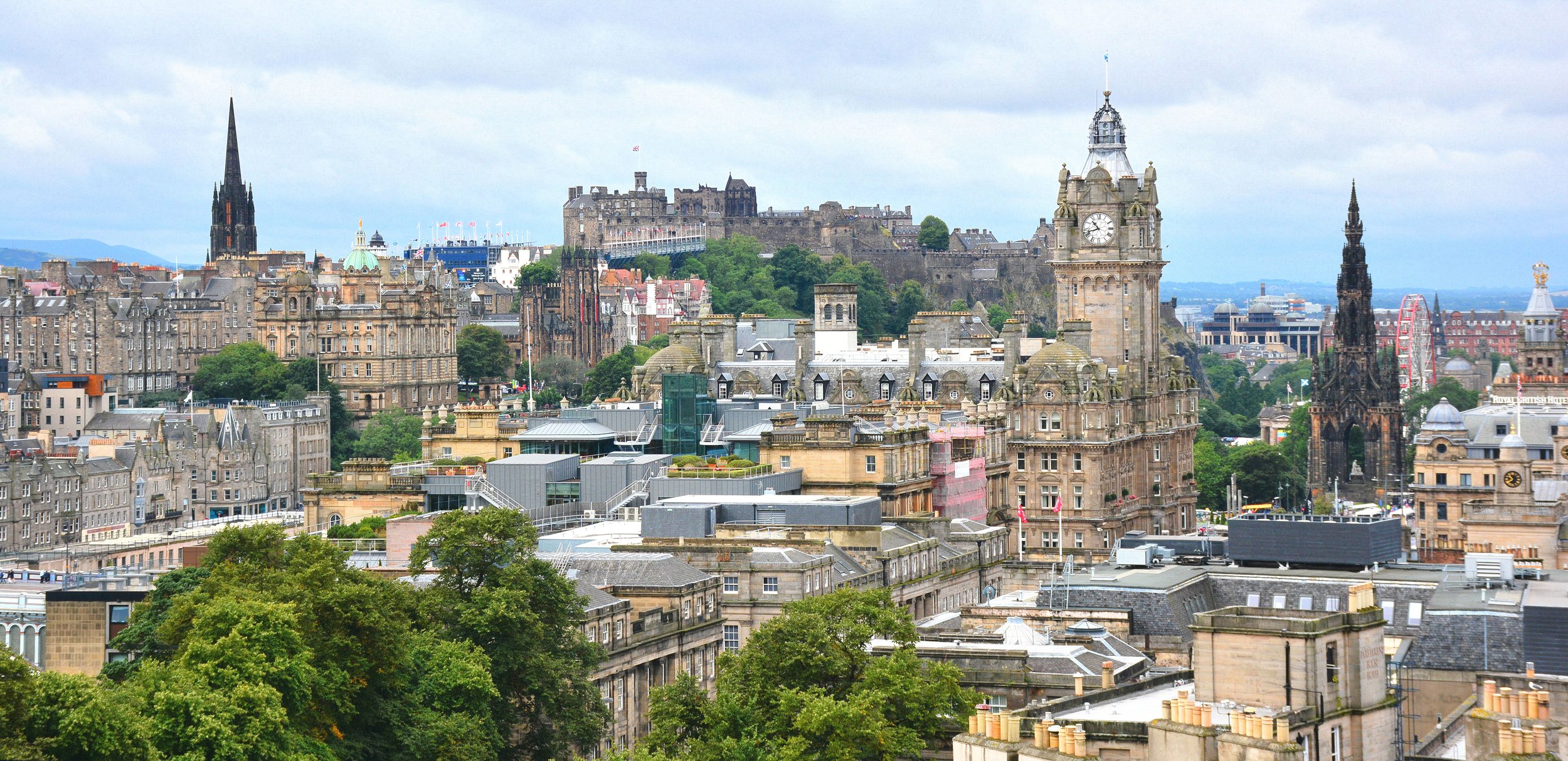For the past 600 years, dancers in Papantla, Mexico, have taken to the skies to perform the acrobatic spectacle, the Danza de los Voladores (Dance of the Flyers). Four flyers and one guide dressed in vibrant colors ascend a 20-meter pole, anchored only by a single rope tied to their legs. There, they begin the ritual, flying through the air to ask the sun deity for rain and blessings.
The Island of Sardinia
Located off the western coast of Italy, Sardinia is a beautiful island well known for its history, beaches, rock formations and caves.
Porto Giunco in Sardinia. Tjshot. CC BY-NC-SA 2.0.
Among all the islands in the Mediterranean Sea, the two largest ones belong to Italy. Sicily is the largest and one of the most well-known for its beauty, but Sardinia, the second largest, is equally beautiful. Like the rest of Italy, it has its own rich history that goes back thousands of years that stretches back before the Roman Empire. Beyond that, the island is known for its beaches and rock formations, but apart from the coastline, the island is also very mountainous. Its highest point, Mount La Marmora, stands at 6,017 feet (1834 m).
One of the most distinctive features of Sardinia are the nuraghes, which are small buildings built in the prehistoric times. There are no records of the people who built and lived in them, but archeological evidence seems to suggest that whoever lived there had an organized tribal system. The Phoenicians came to the island because of the mines, but it eventually passed into Roman rule. Since then, the island has been under the control of many nations. Because of that, Sardinia also has a unique Italian dialect known as Sardu. Interestingly enough, most Italians do not understand the Sardinian dialect and it sounds closer to Spanish than Italian. The language is also very articulate, so in the past, Italians considered it barbaric in comparison to their much softer sounding Italian.
Many ruins from the past are found on Sardinia. The nuraghi are scattered across the island, as are other ancient settlements and towers dating back to the Bronze Age. There are also tombs known as tombe dei giganti, or tombs of the giants, and domus de janas, or fairy houses tombs. But beyond the ancient history, Sardinia’s beaches are also major attractions for the island. They are long and white, often compared to the beaches in the Caribbean, and they regularly make the polls for the best beaches in the world. Is Aruttas, Spiaggia di Piscinas, Spiaggia Rena Bianca and La Maddalena are some of the most popular beaches on the island. Near the sea, too, are the rock formations. Capo Testa is a popular spot to see them. It is near the water but as they are rocks, it requires some hiking, and it does not have the long stretches of white sand. Wind from the Mediterranean has smoothened the rocks over thousands of years, and it has been powerful and persistent enough to shape some of them, which is why the rocks at Capo Testa have such interesting forms. Lastly, the grottos across Sardinia are as equally beautiful and impressive as the beaches and rock formations. There are dozens of caves beneath the island and many are accessible for tourists to visit. The Grotto di Nettuno is one of the most famous caves, and inside it lies an entire lake and large stalactites. Another impressive cave is Grotto Verde, literally translated to “Green Cave”, because of the moss that grows along the stalactites, turning it green.
Grotto di Nettuno. Klaus Nahr. CC BY-SA 2.0.
Like every region in Italy, Sardinia has its own food culture. They do have their own pasta specialities, like malloreddus that is made in a curved shape in order to better catch sauce and cheese. This particular type of pasta is eaten with a sauce called Campidanese and it is made up of saffron, sausages with fennel seeds, tomatoes and Pecorino cheese. In fact, Pecorino cheese originated from Sardinia. It is very popular and goes with many pasta dishes or melted in a sandwich.
Of course, since Sardinia is an island, they are also known for their seafood. Their seafood pasta, fregola ai frutti di mare, is interesting because the noodles are cooked like a risotto. Sardinians also love sea urchins, so much so that they hold sea urchin festivals. The sea urchins are commonly eaten with spaghetti, but the festivals also serve other seafood such as swordfish, tuna carpaccio and fried fish.
Katherine Lim
Katherine Lim is an undergraduate student at Vassar College studying English literature and Italian. She loves both reading and writing, and she hopes to pursue both in the future. With a passion for travel and nature, she wants to experience more of the world and everything it has to offer.
CATALYST Fall Reading List: Top 10 Books
Now that beach reads are back on the shelves, it’s time to cozy up with these fall titles. CATALYST provides ten of the hottest books right now to add to your bookshelf.
Finish your summer reading? Good, because CATALYST’s lineup of new books for the fall provides wondrous worlds to explore, without leaving the comfort of your favorite reading chair. From elegiac poetry to bracing memoir to transgenerational fiction, this list offers a diverse array of books that comprise a who’s who and what’s what of the literary world today. From some of literature’s biggest names to lesser-known geniuses, these books promise to widen your scope of what books can accomplish–and of where they can take you.
1. Young MungoDouglas Stuart
Douglas Stuart follows his worldwide sensation “Shuggie Bain” with this tender, brutal novel of young working-class love between two young men. Mungo and James are born on opposite factions of a sectarian divide- Mungo on the Protestant side and James on the Catholic side. Despite their differences, however, they forge a friendship – and something more – that simultaneously threatens life as they know it but promises to change it for the better. This heartbreaking novel ends with a search for both inner and outer peace that provokes thought as much as it does tears.
Colson Whitehead takes his reader back in time with his latest outing. “Harlem Shuffle” tells the story of the scrappy social climber Ray Carney, full-time furniture salesman and part-time crook, as he learns the true rules and rulers of his beloved New York City. When he takes part in a heist of Harlem’s most esteemed hotel, he puts his whole life in jeopardy. In lavish prose, Whitehead paints a vivid picture of Harlem in the 1960’s such that his novel becomes a love letter to a bygone era. But will Ray Carney be able to survive the twists and double-crosses that comprise his life-story and make it to the better neighborhood he has always dreamed of?
What do you get when you mix an audacious heist, a biting social commentary and a moving love story? You get Rahul Raina’s “How to Kidnap the Rich”. This hilariously chaotic novel follows Ramesh Kumar, a brilliant yet impoverished young man who serves India’s upper-class by acing SAT tests for children. When his client Rudi Saxena places first in the national university entrance exams, he seeks to capitalize on his success, only for both of them to be kidnapped. What follows is a thrilling page-turner replete with caustic barbs against India’s upper-class. A searing, incendiary novel, “How to Kidnap the Rich” will surely captivate any reader who delights in double-crosses and thought-provoking satire.
Living at the intersection of blackness and queerness, George M. Johnson is uniquely situated to perceive the injustices faced by queer Black youth. Perhaps that is why he wrote “All Boys Aren’t Blue” as a series of essays designed to advise and guide young adults, though the book’s messages resonate for readers of all ages. From being bullied as a young child, to his first sexual experiences, to the support network that saw him through his life’s worst travails, this book covers territory from which most authors shy away, but ultimately in the service of love, Johnson seeks to confront this territory. In telling his story, Johnson provides reader’s a mirror in which they can see themselves reflected. Hopefully, they will also see, as Johnson ultimately did, a path towards healing.
This graphic novel explores the ambiguities of gender and sexuality, which is experienced at a young age in a political moment defined by anti-LGBTQ+ backlash. “Gender Queer” is the most banned book in the United States, according to the New York Times, thanks to conservative activist movements that object to its frank depictions of gender dysphoria, sex and sexuality. At heart, it is a compelling story of Maia Kobabe’s quest towards self-discovery as a non-binary person. Its gorgeous images and thoughtful meditations are the best alternative to a public debate around gender that grows more raucous by the day.
From blue-bearded millionaires to ravenous wolves, the women of “How to Be Eaten” have survived some of fairy tales’ most devilish, nefarious men. Adelmann’s second book and first novel follows the female characters of some of the Brothers Grimm’s most famous yarns as they attend a trauma therapy group, where they process the immense harm done to them by their male counterparts. By turns wicked and uplifting, this book ultimately indicts the reader’s craving for a clear-cut happy ending. Sadly, love in Adelmann’s telling is not as easy as the Brothers Grimm would have us believe.
Famed Nobel Prize winner Kazuo Ishiguro turns his incisive, writerly gaze to the sci-fi genre with “Klara and the Sun”. Lonesome yet insightful, Klara is a robot who watches the world pass by from her perspective in a shop that dispenses Artificial Friends. When her life stands to change forever, she finds that her hopes may have been misleading her all along. Told in Ishiguro’s subtle and revelatory voice, “Klara and the Sun” is an accomplished addition to the author’s already impressive body of work.
Author Iain Sinclair is famous for pushing and obscuring the boundaries between different media. In this book, he uses his multidisciplinary approach in the service of nonfiction. “The Gold Machine” relays his travels with his daughter through Peru following the trail of his great-grandfather. What he finds is the wreckage wrought by British colonialism and the still-open wounds of a country recovering from history. At once hypnotic and bracing, “The Gold Machine” charts colonialism’s legacy in the most personal of terms.
Ocean Vuong has catapulted poetry into the public spotlight with his arresting voice, palpable heart and his search for passion. He follows his autobiographical debut “On Earth We’re Briefly Gorgeous” with a second poetry collection, which continues the themes he has explored in his earlier poetry and fiction. Written in the wake of his mother’s death, Vuong captures the debilitating stagnation of grief but hints towards the means by which it is overcome. Inspiring, breathtaking and true, “Time Is a Mother” renews the reader’s faith in poetry to tell the heart’s most revealing secrets.
10. Homegoing Yaa Gyasi
As debut novels go, “Homegoing” is ambitious. It covers seven generations of a family’s history, tells that story from fourteen different perspectives and does it all in 300 pages. Despite the odds, the book soars. An almost impossibly moving novel about two sisters prohibited from knowing each other by the structures of British colonialism, Effie and Esi lead vastly different lives but are still in part defined by the racist eras they inhabit. From the Atlantic slave trade to the jazz clubs of Harlem, “Homegoing” captures the grief of the Ghanaian diaspora while illustarting the beauty and love that emerged from tragedy.
Michael McCarthy
Michael is the CATALYST book editor and curator. His fiction, nonfiction, interviews, and book reviews have appeared in The Adroit Journal, Barzakh Magazine, Beyond Queer Words, and Prairie Schooner, among others. Currently, he is transferring from Haverford College to University of Carlos III in Madrid, Spain, where he intends to major in the Humanities. He is also seeking publication for his poetry chapbook Steve: An Unexpected Gift, written in memory of his late uncle. He can be reached at @michaelmccarthy8026.
Chasing Aurora: Where To See The Northern Lights
From Norway to New Zealand, these five spots are perfect for experiencing the elusive beauty of the Aurora Borealis.
The Northern Lights as seen from the southern coast of Iceland. Cameron Pickett. CC BY 2.0.
The Aurora Borealis, better known as the Northern Lights, is one of the most magical natural phenomena to witness in person. It is caused by electrical interactions in the upper atmosphere that release waves of normally green and yellow light depending on which elements have reacted. Environmental conditions need to be perfect in order to properly experience the true beauty of the elusive lights, but there are a few locations near the Arctic Circle from which they are easier to spot. Here are five locations with an exceptionally good view for those who are trying to catch a glimpse of the lights, adjusted for the current astronomical layout of the planets and stars.
1. Rovaniemi, Finland
The Northern Lights shining down on the Santa Claus Village in Rovaniemi, Finland. Santa Claus Village. CC BY-NC-ND 2.0.
The city of Rovaniemi is the capital of Lapland, and is also well publicized as being the hometown of Santa Claus. Situated right on the Arctic Circle, it is most easily reachable by plane from Helsinki, though it is also accessible by local trains and buses. Rovaniemi is famous for its natural beauty -- its northern latitude makes it perfect for those wanting to experience the ‘midnight sun’ phenomenon, where our star is visible for a whole 24 hours. The city is the perfect destination for travelers looking to enjoy the Northern Lights, with the optimum viewing times occurring between August and April.
2. Yukon, Canada
The Northern Lights over Kluane Lake, Yukon. Keith Williams. CC BY-NC 2.0.
Located in the north east corner of Canada, the Yukon territory is home to almost 22,000 square kilometers (around 8,500 square miles) of protected land as part of the Kluane National Park and Reserve. Visitors can reach the park by plane, boat or car to visit the country’s largest ice field, an incredible grizzly bear population, and even Mount Logan, Canada’s highest peak, which stands just under 6,000 meters (around 19,685 feet) tall. While the Northern Lights can be seen from most of Canada’s provinces, the display is visible to those in the Yukon from August to April, making it one of the longest viewing seasons in the country.
3. Reykjavík, Iceland
The Northern Lights seen from a small cabin just outside of Reykjavík, Iceland. Davide Cantelli. CC0.
The Icelandic capital of Reykjavík is by far the largest city in the country and is also one of the best places to watch the Northern Lights. Just a few degrees south of the Arctic Circle, many residents of the city claim to see the display from their windows on especially bright nights. Visitors can fly directly into the city’s airport and enjoy various other outdoor activities including icy glacier hikes, swimming in natural hot springs during the day and venturing to Thingvellir National Park, which is just a short drive from the city to see the aurora. Though brighter auroras can be seen from the city, avoiding light pollution makes it much easier to experience the full display between September and April.
4. Tromsø, Norway
The Northern Lights shining over the mountains in Tromsø, Norway. Maria Wulff Hauglann. CC BY-NC 2.0.
Located in the heart of the northern aurora zone, the Norwegian city of Tromsø is most well-known for its view of the Northern Lights. Visitors can book one of the many available aurora tours hosted by guides who have expert knowledge of the best local sites from which to watch the display. Many of these base camps offer excellent viewing of the lights from September all the way till April. Tromsø is just a quick 3.5 hour flight from London for those wanting to experience the local Sami culture, or for those simply looking to indulge themselves in the city with the most bars per capita than any other in Norway.
5. Kiruna, Sweden
The Northern Lights as seen from the town of Kiruna in Swedish Lapland. Martin Eklund. CC0.
The wilderness of Swedish Lapland is perfect for those looking to enjoy the Northern Lights away from other tourists. Additionally, the complete lack of light pollution allows for a particularly vibrant viewing. As the northernmost city in Sweden, Kiruna is located well within the Arctic Circle and is home to the largest underground iron ore mine in the world. The town also neighbors Jukkasjärvi, a town made recently famous for its hotel made entirely of ice. Visitors who stay here can typically enjoy the lights between September and March, though the season can often begin slightly earlier and end slightly later.
Bonus: Queenstown, New Zealand
The Southern Lights captured near Queenstown, New Zealand. Bec Potter. CC BY-NC-ND 2.0.
This final destination highlights the resort town of Queenstown on New Zealand’s South Island. Unlike the other places on this list, it is a perfect place to experience the natural phenomena known as the Aurora Australis or the Southern Lights. This aurora is similarly caused by interactions between molecules in the upper atmosphere, which release waves of light across the night sky, though the Southern Lights tend to appear red and pink. This is due to the types of gas that are interacting and the atmospheric height at which the interactions take place. Visitors can fly straight into Queenstown’s international airport and enjoy the natural beauty of the nearby Lake Wakatipu during the day, before settling in to watch the display at night.
Tanaya Vohra
Tanaya is an undergraduate student pursuing a major in Public Health at the University of Chicago. She's lived in Asia, Europe and North America and wants to share her love of travel and exploring new cultures through her writing.
Keeping It Clean: 5 Ancient Baths From Around The World
These bathing sites, some dating back centuries, tell stories about ancient cultures that can still be explored so many generations later.
Read MoreCrazy Rock Formations, Lofty Cliffs and Sea Views: 5 Sites to Visit in Ireland
Ireland has an endless array of once-in-a-lifetime natural sites to visit, and here are the top five to add to your list.
Giant’s Causeway, Northern Ireland. Sean MacEntee. CC BY 2.0.
Ireland has several natural sites that beautifully reflect almost unbelievable geographical occurrences from hundreds to thousands of years ago. Some of these sites include towering cliffs overlooking the Atlantic Ocean and rock formations created by causes ranging from volcanic activity to major storms on the sea. Below are five of the most stunning natural sites that Ireland has to offer, and the unique features of each one.
1. Giant’s Causeway
Giant’s Causeway. Sean MacEntee. CC BY 2.0.
Giant’s Causeway is the only UNESCO World Heritage site in Northern Ireland, boasting a cliff made up of around 40,000 basalt columns overlooking the sea. These columns are believed to have been formed 50-60 million years ago as the result of volcanic activity. The columns are especially impressive, as in certain places they line up almost perfectly to create the appearance of a flat pavement. While scientists know the true story of how Giant’s Causeway was formed, a famous legend attributes the columns to a feud between an Irish and Scottish giant. The legend states that the Scottish giant created a stone pathway to cross the sea to Scotland, and the Irish giant destroyed the pathway, creating Giant’s Causeway. In terms of accessibility to travelers, Giant’s Causeway is a good destination because it is free to hike, unless one wants to use certain visitor’s services such as parking.
2. The Cliffs of Moher
Cliffs of Moher. Martin Abegglen. CC BY-SA 2.0.
The Cliffs of Moher, spanning a massive 14 kilometers, are famous for their abrupt edge, which falls vertically into the Atlantic Ocean. The Cliffs of Moher offer many beautiful views and experiences such as stunning sunsets, a look-out tower from the 1800s and walking trails throughout. Some even recommend viewing the cliffs from below, by boat. Unlike Giant’s Causeway, the Cliffs of Moher are not free to enter, but only cost eight euros for adults. A fun fact about the Cliffs of Moher is that a scene in the sixth Harry Potter movie was shot there, which emphasizes how striking and magical these cliffs are.
3. Sliabh Liag
Sliabh Liag. Greg Clarke. CC BY 2.0.
Sliabh Liag (pronounced “sleeve league”) is another set of cliffs in Ireland overlooking the Atlantic Ocean. The Sliabh Liag cliffs are less famous than the Cliffs of Moher, but they are just as stunning. In fact, they are Ireland’s highest cliffs overlooking the sea — almost three times as tall as the Cliffs of Moher — despite being less well-known. The cliffs have both driving and hiking routes and are free to visitors.
4. Carrauntoohil
Carrauntoohil. Tom Fahy. CC BY-NC-ND 2.0.
Carrauntoohil is Ireland’s highest mountain, standing at 1038 meters (3,407 feet). Carrauntoohil is a popular destination for hikers and rock climbers, with several different trails of differing difficulty to choose from. Like Sliabh Liag, it is also a free destination. There are four main trails: Brother O’Shea’s Gully Trail, Devil’s Ladder Trail, the Caher Trail and Coomloughra Horseshoe Loop. These trails have combinations of climbing and hiking, and on average take between four and eight hours to complete. While Carrauntoohil is a popular destination, it is considered difficult to complete one of the trails, and hiking experience is recommended. Travelers are also advised to plan well for their hike, bringing ample food and water, checking the weather and going with a tour group or guide if they are inexperienced.
5. Dun Briste
Dun Briste. Diego Sideburns. CC BY-NC-ND 2.0.
Dun Briste is an incredible naturally occurring rock formation that stands straight up out of the sea. It is commonly referred to as a “sea stack” due to its unusual shape and is thought to have been formed in 1393, which is extremely recent for a rock formation to have been formed. It is believed that there was an archway connecting Dun Briste to land which collapsed. The rock formation is a one-of-a-kind naturally occurring site and is also a haven for birds, as animals that don’t fly aren’t able to reach it. Thus, birdwatching is one of the most popular activities for travelers viewing Dun Briste.
Calliana Leff
Calliana is currently an undergraduate student at Boston University majoring in English and minoring in psychology. She is passionate about sustainability and traveling in an ethical and respectful way. She hopes to continue her writing career and see more of the world after she graduates.
A Vast Wilderness: Visiting Northern Canada
The northern parts of Canada are extremely isolated and difficult to reach, but they are full of diverse landscapes.
Read MoreThe Trans-Siberian Railway and the Lost Art of Train Travel
The Trans-Siberian Railway, the longest railroad line in the world, is an example of the joy that train travel can bring.
The Trans-Siberian Railway passes through Dornogovi, Mongolia. Boccaccio1. CC BY-NC-SA 2.0.
The popularity of railroad travel has diminished in the modern age. Cars allow for a freedom of movement that would be impossible on a train, and airplanes take the traveler farther and faster than railroads could dream of. The role of trains in the last 75 years has seemingly become filling in the gaps left by other forms of transportation. Stiff and awkward journeys of a few hours, connecting two cities with sterile cars and rusty tracks, are far too common, at least in the United States. But the beauty of a train trip is still attainable. Travelers can get a Eurail pass and travel across Europe, or take a private railway through rural Japan. Or they can do one better, and take the Trans-Siberian Railway.
Although it is actually a single collection of routes within the massive Russian rail network, the Trans-Siberian Railway is famous in its own right. It is the longest railway line in the world, with its longest route connecting Moscow and Vladivostok over 5,772 miles. It is also historic; the railway’s construction began in 1891 when Russia was still a Tsarist state, and it continues to be developed today.
Russia, especially Siberia, is not a place noted for its tourism. Yet the Trans-Siberian stands as a shining light in the nation’s wintery darkness. The railway is cheap, comfortable and most importantly, gives you that rollicking, adventurous spirit that only good train trips can.
A Trans-Siberian trip is also extremely flexible. One can start at St. Petersburg or Moscow and head east, or start in the east at Vladivostok or Beijing. Trains from Europe connect to the Trans-Siberian in St. Petersburg and Moscow, which means that it is possible to take a train trip from Paris all the way to the eastern coast of Asia.
The Trans-Siberian Railway in Irkutsk. Wazari Wazir. CC BY-NC-SA 2.0.
Something that differentiates railways from other modes of travel is that you can, and are supposed to, get off. The Trans-Siberian is no different. There are incredible landmarks at every stop on the journey; it’s easy to arrange to check out the ice lakes in Irkutsk or to visit the Naadam festival in Ulaanbaatar over the course of your trip.
Stepping off the train and seeing Siberia is part of the fun, and every traveler who rides the Trans-Siberian is encouraged to at least walk around a bit while the train is stopped at each station. But the train itself is an enjoyable space to live in. There are a few different options to choose from when buying tickets: most travelers choose second class (known as “kupé”), which reserves a spot in an air-conditioned car with four beds, but there is also the pricier first class (“spalny vagon”), a car with two beds, and third class (“platskartny”), an open car stuffed with fifty-four bunks. Travelers are sure to meet people in whatever class they choose, as late nights spent in the restaurant car playing cards and drinking vodka are common. Platskartny is probably the most genuine Trans-Siberian experience, as you will be surrounded by Russian commuters and travelers. But platskartny is also quite cramped and noisy, and the privilege of having a semi-private bathroom is lost. It is something to consider before you snap up a super-cheap ticket.
The Trans-Siberian Railway is not a tourist line; it is a real, historic railway that people around Asia use to see their families and take vacations themselves. As such, one should treat it and the people on it with respect. One should also do some more research about the train before planning a trip; there are many helpful websites with information about the Trans-Siberian, such as Seat 61’s extensive article.
The Trans-Siberian Railway, overlooked to many outside Asia, is perhaps the last vestige of old-fashioned rail travel. As a consequence, it has a unique effect on the land it passes through. The secrets of Siberia would stay unseen on an airplane over 30,000 feet in the air. But n the railway, the place has no choice but to reveal itself.
Finn Hartnett
Finn grew up in New York City and is now a first-year at the University of Chicago. In addition to writing for Catalyst, he serves as a reporter for the Chicago Maroon. He spends his free time watching soccer and petting his cat.
Musical Styles Worth Exploring in Lusophone Countries
Music spoken in Portuguese (more commonly known as Lusophone) often stems from Brazil, Mozambique and Cape Verde. From bossa nova, to MPB to Tropicalia, learn and listen in this article on some amazing musical traditions.
Read More7 Real Life Locations In Great Works of Art
It is not necessary to go to a museum to experience the awe of a painting—try visiting the actual locations they were based on instead.
Kindred Spirits by Asher Brown Durand is a painting set in the Catskill Mountains of New York. Asher Brown Durand. CC0 1.0.
Museums and galleries are prime places to see great works of art. There are long lines at the Louvre in Paris, the Metropolitan Museum of Art in New York and the Uffizi Galleries in Florence. But you do not need to be in a museum to experience a painting. Many famous works of art are based on real life locations that visitors can explore for themselves. It is often possible to experience the same emotions that the original artist felt when painting the subject. Here are 7 real life locations of famous paintings that you can visit.
1. The Dibble House, Iowa, United States
American Gothic. mark6mauno. CC BY 2.0.
Dibble House. photo librarian. CC BY-NC-ND 2.0.
In the summer of 1930, Grant Wood was driving around Eldon, Iowa when he noticed the Dibble House. It was not a beautiful house to Wood, but he found it captivating due to the absurdity of putting a gothic-style window in such a flimsy house. He made a sketch of the house and the final product became “American Gothic”, a famed work illustrating small-town America. Today, visitors are welcome to visit the house and have their photo taken outside, usually with the provided jackets to make it look like a reenactment of the famous painting. Next door is also the American Gothic House Center, which hosts exhibits on the famous painting.
2. Arles Cafe, France
Cafe Terrace at Night. Greg_e. CC BY-NC-SA 2.0.
Arles cafe. Greg_e. CC BY-NC-SA 2.0.
Arles is the town most closely associated with Vincent Van Gogh. He lived there from 1888 to 1889, where he painted some of his most famous post-impressionist pieces, including the “Cafe Terrace at Night”. The setting of that work is the Cafe du Forum and is now called the Cafe La Nuit, which still exists today on the Place du Forum in Arles. That cafe was refurbished so that it looks exactly like how Van Gogh would have seen it. Gas lamps still light the site. Van Gogh also painted a companion piece of the interior of the same cafe. Today, visitors can experience the cafe and Arles much like how Van Gogh would have seen it.
3. Mount Holyoke, Massachusetts, United States
The Oxbow. wallyg. CC BY-NC-ND 2.0.
Mount Holyoke. pecooper98362. CC BY-NC 2.0.
Thomas Cole was one of the chief proponents of the Hudson River School, a school of art that specialized on landscape paintings in the early American republic. At that time, a uniquely American art-style was being created, and in his work “The Oxbow”, exemplifies that. That painting shows Mount Holyoke and a view that shows Americans conquering the wilderness. The view from the mountain today is much different than the one in Cole’s painting, as the area around it is much more built up, but the mountain itself is part of Skinner State Park. A road brings visitors up the mountain in the summer months and a number of hiking trails criss-cross the mountain.
4. Valley of Mexico, Mexico
The Valley of Mexico from the Hillside of Santa Isabel. profzucker. CC BY-NC-SA 2.0.
The Valley of Mexico. Gary Denness. CC BY-NC-SA 2.0.
Similar to the Hudson River School, art in Latin America during the 19th century was also used to inspire nationalism. Jose Maria Velasco painted a landscape of the Valley of Mexico from the hillside of Santa Isabel to exemplify that nationalism. That landscape combines pre-Columbian symbols to represent a shared Mexican heritage. That valley today is built up as it is the location of the sprawling Mexico City. However, the hills above the valley offer stunning views of the area. Desierto de los Leones National Park, located 3.2 kilometers southwest of the city, offers panoramic views that gives a glimpse of what Velasco saw when he painted “The Valley of Mexico from the Hillside of Santa Isabel”.
5. Giverny Gardens, France
Waterlilies. Art That Inspires. CC BY-NC 2.0.
Giverny gardens. Trey Ratcliff. CC BY-NC-SA 2.0.
Claude Monet was the pioneering impressionist painter, shocking the art world with his visible brush strokes. One of his most famous works is “Water Lilies”, a collection of paintings of waterlilies in his garden in Giverny, France. Today, Monet’s home and gardens in Giverny can be toured by visitors. He had a garden called the Clos Normand in front of his home and a Japanese-inspired garden across the street, where visitors can admire its natural beauty. Much of his paintings from the “Water Lilies” series are based on his Japanese garden.
6. Mount Fuji, Japan
The Great Wave Off Kanagawa. kendo_. CC BY-NC-ND 2.0.
Mount Fuji. Trey Ratcliff. CC BY-NC-SA 2.0.
“The Great Wave Off Kanagawa” is arguably one of the most well-known Eastern works of art, but most people do not know that it is part of the series 36 Views of Mount Fuji by Katsushika Hokusai. While in “The Great Wave”, Mount Fuji only appears as a small cone in the horizon, almost blending in with the other wave crests, in other prints of the series, Mount Fuji gets a more pronounced position. Being the highest mountain in Japan and holding a special place in Japanese culture, Mount Fuji is easily accessible to visitors. The mountain is easily viewable from the shinkansen between Tokyo and Nagoya, but for a closer look, visitors can head to the Fuji Five Lake region at the northern base of the mountain. Mount Fuji is open to climbing in the summer months on some seasonal routes.
7. The Delft House, Netherlands
The Little Street. Gandalf’s Gallery. CC BY-NC-SA 2.0.
Delft House. 1Veertje. CC BY-SA 3.0.
Johannes Vermeer only has less than 40 paintings still in existence, but he is still considered one of the greatest Dutch painters. His painting “The Little Street” attracted researchers trying to pinpoint its exact location for centuries. Now, art historians and other researchers believe that the site of 40-42 Vlamingstraat, in Delft, Netherlands, is the location of the work. Researchers used tax records to narrow down the location in Vermeer’s hometown of Delft. The original buildings in the painting no longer exist, but a gate still exists. It is not possible to enter the buildings, but visitors can still imagine what the area was like in the 17th century when Vermeer worked.
Bryan Fok
Bryan is currently a History and Global Affairs major at the University of Notre Dame. He aims to apply the notion of Integral Human Development as a framework for analyzing global issues. He enjoys hiking and visiting national parks.
7 Active Volcanoes To Visit…If You Dare
With a little careful planning, these seven active volcanoes are the perfect destination for the adventure seeker in you.
Read MoreWhy Japanese Fruit Is So Expensive
Japan places cultural importance on giving fruit gifts, leading to the cultivation of impressive fruits that can cost over $100
Square Watermelon. Joi Ito. CC BY 2.0.
In most parts of the world, fruit is a relatively common food, located in every grocery store and eaten as a healthy snack. However, fruit in Japan is expensive, much more than most would expect. Every piece of fruit is carefully grown and so much importance is placed on this that a single piece of fruit can cost over $200.
Of these expensive fruits, melons are the most famous. Many watermelons are grown in the shape of a cube, though known as square watermelons, and others a heart. Square watermelons were originally developed to make it easier to store them, but they are still watermelons. Yubari melons are also extremely costly, well-known for their sweetness, texture and aroma. They are known as the most expensive fruit because in 2010, a pair of them were sold for $45,000 to a melon-flavored mineral water company celebrating their 10th anniversary. Muscat grapes are also very popular, each one large, plump and shiny. However, the Ruby Roman grapes are even more special. These are grown only in Ishikawa, one of Japan’s prefectures, and a single one of these grapes can cost 2,500 yen (about $18). They are easily the most expensive grapes in the world, but they are also the largest, with each grape as big as a ping pong ball. Though these grapes are also classified into superior, special superior and premium, only 1-2 bunches of grapes are considered premium per year. In 2020, a premium group of Ruby Roman grapes sold for $12,000. Another popular and expensive fruit is the Japanese strawberry. Amao strawberries, grown in Fukuoka, cost around $7 per kilogram, but they are roughly 4-5 times the size of normal strawberries. Hatsukoi no kaori, or white jewel strawberries, are 3 times the size of a regular strawberry, but a singular one of them will cost $10. This is because of the unique color that they are famous for. Hatsukoi no kaori are white strawberries with red seeds, hence the name “white jewel”.
White Jewel Strawberry. Jed Schmidt. CC BY-NC-SA 2.0.
These impressive fruits are expensive for a reason. There is a lot of careful cultivation by the farmers who grow them so that the fruit turn out perfectly. Each farmer has their own way of meticulously taking care of their fruit plants. Some will pollinate each flower by hand, others have hats for their fruit in order to prevent sunburn and the rest will grow the plant so that each branch or vine only has one fruit. This way, all the nutrients in the plant are directed towards that particular fruit.
Display of Expensive Fruit. The Tronodon. CC BY-NC-ND 2.0.
In addition, fruit-giving is an important part of Japanese culture. The seasons play a large cultural role, and fruit represents them because different fruits thrive better during different times of the year. It allows people to experience and appreciate what each season has to offer, from the colors of the fruit, to their aroma and, of course, taste. Beyond that, since fruit is edible, it doesn’t clutter people’s houses. Also, since the fruit is a gift, it has to look perfect. They cannot have blemishes or other imperfections, which is why so much labor and dedication is devoted to growing each luxury fruit.
Katherine Lim
Katherine is an undergraduate student at Vassar College studying English literature and Italian. She loves both reading and writing, and she hopes to pursue both in the future. With a passion for travel and nature, she wants to experience more of the world and everything it has to offer.
Electric Planes: The Future of Air Travel?
United Airlines and Mesa Airlines are buying electric aircrafts from a Swedish startup, to make air travel more eco-friendly.
United ES-19. Wikimedia Commons. CC BY-SA 4.0.
In July, United Airlines announced that they would be buying ES-19 planes. They plan on purchasing 100 of these 19 seat, zero emission planes from a Swedish company called Heart Aerospace. United plans on being able to use these planes by 2026. Since they can only carry a small amount of people, these planes would be used mostly for short distance flights. They have routes planned from their major hubs, such as from Chicago O’Hare International Airport to Purdue University Airport and another route from San Francisco International Airport to Modesto City-County Airport. Heart Aerospace claims that around 4% of emissions around the world come from flights that are less than 200 kilometers (124 miles), and 9% are from flights less than 400 kilometers (250 miles). Using electric planes for these shorter distances would be beneficial in lowering these emissions, which is United Airlines’ plan. They have a goal to reduce 100% of their greenhouse gas emissions by 2050. They also want to achieve this without using the traditional carbon offsets, which are projects for reducing a person’s carbon footprint. These offsets are projects like planting a certain number of trees, improved forest management or capturing greenhouse gas emissions coming from a landfill. There are online calculators that calculate how much carbon dioxide a person is producing by going on a plane somewhere and estimating how much they need to do to cancel it out. United Airlines’ goal is to significantly reduce their carbon emissions without resorting to projects like these.
They are not, however, the only airline that wants to reduce their emissions. Mesa Airlines, a regional American airline, has partnered with them and has purchased the same amount of ES-19s. The CEO of Mesa Airlines, Jonathan Ornstein, has spoken about the opportunities of the electric aircrafts and that it should cost less to operate. Some areas are too small and too close to large cities to have flights, but they can operate profitably with electric planes.Since these electric planes are so small and will cost less to operate, it can become a viable method of transportation to these smaller cities, making it easier to bring people into these areas.
Heart Aerospace, the company manufacturing the ES-19s, believes that electric aircrafts are the solution to lowering carbon emissions caused by air travel. Those emissions make up around 2% of global emissions overall, and by 2050, that number is expected to increase to between 12%-27%, and eliminating the emissions caused from short distance flights with electric planes can prevent that. Since the planes are small, they can use small runways that are more common in smaller cities, and it will be beneficial to them as it will be easier for people to travel. Also, like Ornstein said, the planes will be much cheaper to maintain as the electric motors reduce the cost of maintenance by 90%, and fuel costs will decrease between 50%-70%.
Beyond Heart Aerospace, there are other companies developing electric planes. Wright Electric is one of them, and they are developing a 100 seater plane to be released in 2026. They are also developing one that will have 186 seats and will be able to fly 800 miles, but that is estimated to be completed in 2030. Many other companies are researching electric aviation, as they believe it to be the future of air travel. Even NASA has been researching this, having developed and begun flying their X-57 electric airplane. Airline companies are conscious of their large environmental impact, and many large ones have agreed to participate in the UN’s plan to have net-zero carbon emissions by 2050. The use of electric aircrafts would help these companies a lot in reaching this goal, and because of this, the Swiss Bank USB believes that by 2035, a quarter of air travel will be electric.
Katherine Lim
Katherine Lim is an undergraduate student at Vassar College studying English literature and Italian. She loves both reading and writing, and she hopes to pursue both in the future. With a passion for travel and nature, she wants to experience more of the world and everything it has to offer.
10 of the World’s Best Ecotourism Destinations
Ecotourism aims to preserve the environment while allowing travelers to get a glimpse of the natural world. These 10 destinations are sustainable travel options that will broaden visitors’ understanding of the environment along with other cultures.
Sustainable tourism seeks to strike a balance between the environmental, cultural and economic impacts of tourism, and many destinations around the world are moving toward the model. Ecotourism is a subset of sustainable tourism that focuses specifically on the environment. The International Ecotourism Society defines ecotourism as “responsible travel to natural areas that conserves the environment, sustains the well-being of the local people, and involves interpretation and education.” Ecotourism is not just about seeing stunning parts of the natural world, but about trips that curate awareness of and respect for the global environment and cultures. These 10 destinations are sure to provide memorable travel experiences while heightening visitors’ understanding of the social, political and environmental climates of the places they’re exploring.
1. Galapagos Islands, Ecuador
In 1978, the Galapagos Islands became one of the world’s first UNESCO World Heritage Sites, protected for their unusual plant and animal life that famously inspired Charles Darwin’s theory of evolution. The 19 islands, located about 600 miles off the coast of Ecuador, are home to giant tortoises, land iguanas and many subspecies of finches, as well as huge cactuses and trees unique to the islands. Ninety-seven percent of the islands have been part of a national park since 1959, and human settlement, including tourism infrastructure, is restricted to the remaining 3%. The islands are a paradise of natural beauty, and over 150,000 travelers visit annually. The Galapagos National Park Directorate and the Ecuadorian Ministry of Tourism have implemented regulations that ensure visitors get to explore the islands without harming the environment. The entrance fee that visitors pay for the national park is used to fund conservation projects, the number of tourists at each site at a given time is limited and all travelers are required to have a guide with them as they admire the islands. These guides are trained to educate the visitors and protect the sites, and are often local people, which ensures that travel benefits the local economy.
Social issues: A current issue faced by the local population is the islands’ limited health care system, which consists widely of small, understaffed clinics. Ecuador is preparing for a runoff election for the presidential race, which will take place on April 11. Young people and women are major voter blocs in the election, hoping for policies that will address Ecuador’s economic crisis, inequality and rise in violence toward women.
2. Costa Rica
Over a quarter of Costa Rica’s land is protected from future development. Costa Rica boasts incredible biodiversity, with thousands of different plant and animal species. The journey toward ecotourism in Costa Rica began in 1963 with the establishment of the Cabo Blanco National Reserve. The establishment of national parks quickly followed, and today Costa Rica has 70 separate entities within its park system. Visitors to Costa Rica will see a variety of ecosystems including cloud forests, rainforests, wetlands and coastal marine areas, all bursting with breathtaking plant and animal life. Places to visit include Arenal Volcano National Park, Cano Island Biological Reserve, Monteverde Cloud Forest Reserve and Ballena Marine National Park, though these are only a few of Costa Rica’s many stunning natural destinations. Most of these protected areas limit the number of visitors inside at any given time in order to prevent damage to the environment. The Costa Rican Tourism Board has introduced the Certificate for Sustainable Tourism (CST), which rates businesses, such as tour operators and hotels, on a scale of 0 to 5 based on their environmental, social and economic involvement and impact. The CST system allows tourists to make informed decisions and ensure that their trip is a sustainable one.
Social Issues: A 2020 report revealed that Costa Rica was facing political fragmentation, economic slowdown and increased inequality. Costa Rica’s two major political parties, the National Liberation Party and the Social Christian Unity Party, both recently suffered splits, creating more competing parties. Economic growth has declined, leading to an increase in unemployment rates, and the COVID-19 pandemic has only worsened the situation. The drug trafficking issues that have faced other Central American countries like Honduras and El Salvador have crept into Costa Rica, spurring an increase in violent crimes.
3. Sabah, Malaysia
Sandakan, in Malaysia’s Sabah state, is home to the Sukau Rainforest Lodge, a lodge designed to be as eco-friendly as possible while still offering guests a comfortable and memorable experience. The lodge opened in 1995 and was the first in the area built on ecotourism principles. It is known as an ecolodge, a lodge which embodies the principles of ecotourism: protection and conservation of nature, benefiting the local community and offering programs to educate travelers about the natural and cultural environments they are visiting. A few of Sukau’s eco-friendly practices include rainwater harvesting, which makes the lodge 100% self-reliant for water, no radio or television in the rooms to eliminate some noise pollution and let guests focus on nature, employing a staff made up of 90% Indigenous people, and contributing $16,400 annually to conservation projects in addition to conservation levies collected from guests. A full list of Sukau’s sustainable policies can be found here on the lodge’s website. The lodge rises on stilts over the bank of the Kinabatangan River in Borneo, immersed in nature. Visitors to the lodge will have ample opportunities to spot orangutans, pygmy elephants, proboscis monkeys and hornbills in their natural habitat. Sukau offers a number of tour packages to explore Borneo by land or boat and experience its unique landscapes.
Social Issues: In 2020, Malaysia’s government, headed by Prime Minister Muhyiddin Yassin, cracked down on protests and critical speech, began regulating freedom of expression and started taking a harsh stance on refugees, saying that they have no status or rights within the country.
4. Rwanda
Rwanda has enjoyed a major tourism boom in recent years, and the country has made a strong effort to promote ecotourism. Known as “the land of a thousand hills,” Rwanda is full of beautiful, green landscapes, bamboo forests, volcanoes and incredible animal life, such as the endangered mountain gorilla. A number of new ecolodges have been constructed and are helping to fund reforestation efforts for indigenous trees. Rwanda’s number one ecotourism attraction is Volcanoes National Park, which is home to the mountain gorilla population. The park protects the Virunga Mountains, a chain of dormant volcanoes in the far northwestern corner of the country. The park encompasses a wealth of ecosystems, including evergreen and bamboo forests, sprawling grasslands and swamps. Visitors to the park can purchase tracking permits that allow them to go on mountain gorilla safaris and surround themselves with these amazing animals. The proceeds from the tracking permits go to improving the community development of areas around the park. There are a number of other locations for sustainable wildlife safaris in Rwanda, like Nyungwe Forest National Park and Akagera National Park. Visitors seeking to immerse themselves in local culture should explore the Iby’Iwacu Cultural Village, a traditional Rwandan village located within Volcanoes National Park. Stays in the village can be booked through Gorilla Guardians, a nonprofit organization that aims to improve the lives of reformed poachers and communities around the park. Visitors must abide by a set of sustainable living guidelines as they receive guided tours of the community from locals, learn about the area’s history and experience traditional arts practices, in order to ensure that travel is beneficial to both the tourists and the local community.
Social Issues: Rwanda was the site of mass genocide in 1994, when members of the Hutu ethnic majority murdered around 800,000 people, mostly members of the Tutsi minority. As of 2020, the masterminds of the Rwanda genocide were still being brought to justice in international courts. In 2018, Rwanda implemented major legislative reforms, including a revised penal code, a new code of criminal procedure, and counterterrorism legislation. The country still faces strong limits of freedom of expression, with critical speech resulting in incarceration and even enforced disappearances.
5. Bocas del Toro, Panama
Sometimes called the “Galapagos of the Caribbean,” Bocas del Toro, off the northern coast of Panama, is a haven of biological diversity and spectacular scenery. Made up of nine islands, the archipelago is home to Isla Bastimentos National Park, Panama’s first national marine park. Visitors to Bocas del Toro can zip line through the rainforest, scuba dive in tropical coral reefs, swim with manatees, learn to surf in the Caribbean and sail from island to island to see what each has to offer. Playa Larga on Isla Bastimentos is an annual nesting site for four endangered species of sea turtles. Isla Bastimentos National Park also protects diverse forests, 28 species of amphibians and reptiles, monkeys, sloths and crocodiles. Visitors can go on tours of the islands led by members of Bocas del Toro’s Indigenous tribe, known as the Ngobe-Bugle, to learn more about the area’s history and culture while admiring the plant and animal life.
Social Issues: A significant issue in Panama is poverty. There is a large wealth gap between urban and rural areas; rural areas are less aided by economic booms and have worse access to good health care and education. Rural areas that are largely inhabited by the Indigenous population are especially impacted by this wealth gap, with 86% of Panama’s Indigenous population living in poverty.
6. Sorsogon, Philippines
Located in Sorsogon province in the Philippines, Bulusan Volcano Natural Park is home to a wide range of natural features that make it a great destination for nature lovers. The park surrounds the active Bulusan Volcano and includes lush rainforest, two gorgeous lakes and two large mountain peaks. Visitors can kayak, hike, climb, see indigenous plants and animals, and visit local villages within the park. A number of local communities still flourish in the park, using the lower slopes of the mountains as agricultural lands. Many Indigenous people in the Bulusan Volcano Natural Park area have been trained as guides, allowing visitors to get a firsthand perspective of the park’s culture and environment and providing income for local communities. While in Sorsogon, visitors can also arrange to visit Donsol, where they can see whale sharks up close.
Social Issues: The government of the Philippines is still engaged in its violent “war on drugs,” which began in 2016. The campaign targets mainly impoverished Filipinos in urban areas, and killings by the police related to the “war on drugs” are rampant. Freedom of speech is limited, as those critical of the government face harassment and a number of journalists have been murdered in work-related attacks.
7. Raja Ampat, Indonesia
The Raja Ampat archipelago, located just off the tip of Bird’s Head Peninsula in the West Papua province of Indonesia, consists of more than 1,500 islands. Raja Ampat is extremely remote, meaning it has remained in nearly pristine condition, with white sand beaches, sparkling blue waters, interesting caves and jungle-covered hills that make it known as one of the most beautiful archipelagos in the world. Raja Ampat is also a biological hot spot, rife with varied marine life. The area’s extensive coral reef makes it a major attraction for divers and other visitors who want to experience the natural majesty of the islands. As tourism began to rise in the formerly remote area, the government and nonprofit conservation organizations recognized the necessity of protecting the area’s incredible biodiversity and quickly implemented sustainable ecotourism policies. Numerous programs about Raja Ampat’s ecosystem were developed to educate visitors and locals alike about the need for conservation. The tourism industry is also mainly staffed by local islanders, allowing them to share their culture with visitors while advancing their livelihoods. Tourists can choose from a number of ecolodges to stay in and tour with, such as Papua Explorers.
Social Issues: LGBTQ+ rights have long been under fire in Indonesia, used as a rallying cry and platform for conservative social and political groups. The rights to freedom of expression and peaceful assembly are limited, and human rights defenders are often criminalized.
8. Mai Chau, Vietnam
In the Mai Chau Valley, located roughly 90 miles outside of Vietnam’s capital of Hanoi, traditional villages lie among rice paddy fields and border towering mountains. Mai Chau is full of functional communities and is a popular destination for visitors seeking to immerse themselves in local culture while surrounded by some of Vietnam’s most remarkable scenery. Mai Chau is home to multiple homestay villages, where visitors can stay overnight in stilt houses around Hieu village. Those staying in Mai Chau homestays will eat home-cooked meals and can explore the villages and purchase local crafts. The valley has no shortage of day hikes, and travelers can even rent bicycles to ride from village to village. Mai Chau is located near Hoa Binh Lake and the Pu Luong Nature Reserve, where visitors can see even more of the beautiful ecosystems Vietnam has to offer. Tourism in the Mai Chau Valley is sustainable because it educates visitors about the local culture and environment and stimulates the local economy while having very few negative impacts on the region.
Social Issues: Vietnam has harsh restrictions on freedom of expression, peaceful assembly, association, movement and religion. Political detainees are often held for months without access to legal counsel, and the treatment they face in custody is often violent. Vietnam’s cybersecurity laws allow the government to block websites critical of the ruling party.
9. St. John, U.S. Virgin Islands
In the Caribbean Sea, about 1,000 miles southeast of Florida, are the U.S. Virgin Islands. One of the islands in the group, St. John, is a pioneer of ecotourism. Two-thirds of St. John’s surface area and shoreline waters are set aside as the Virgin Islands National Park, making it the best preserved of the U.S. Virgin Islands. In the water surrounding the island are hundreds of coral gardens, which make up the Virgin Islands Coral Reef National Monument and are protected by strictly enforced laws to prevent damage to the coral. St. John has very little commercial development; the island has no airport, no large cruise dock and no high-rise buildings. The natural integrity of the island is nearly untouched, making it one of the best places in the world to get a real ecotourism experience. Visitors to St. John can explore the national park and learn about the area’s history, seeing petroglyphs carved by the Taino people and the sites of former sugar plantations. Visitors can also relax on pristine beaches, snorkel among the reefs, hike through historic ruins, and sail on crystal-clear waters. There are a number of eco-friendly resorts to choose from in St. John, many of which are campgrounds that offer tents and small cabins.
Social Issues: The U.S. Virgin Islands are fairly dependent on tourism to support their economy. In 2017, two devastating hurricanes, Irma and Maria, hit the islands, inflicting extensive damage and leading to a decrease in revenue which the islands are still trying to recover from.
10. Auroville, India
Auroville, in the Tamil Nadu state of India, is a very unique destination. Auroville is an experimental township that aims to be a “universal town,” where people of all backgrounds can live together in harmony with each other and with nature. Auroville was founded in 1968 by Mirra Alfassa, who is referred to as “The Mother,” and was designed by architect Roger Anger. The township runs on green practices, such as renewable energy, growing some of its own food through farming, recycling wastewater and working to protect the environment with a successful reforestation campaign. The township is financed partially by the government of India, which mostly gives money for education and projects, and partially by nongovernmental organizations, tourists and donors from around the world. Around half of the residents of Auroville are foreign, but they take care not to impose their culture on India, instead hoping to learn about the local culture. They also share their developments in farming with the villages around Auroville.
Visitors to Auroville can book tours to experience life in the town, or stay for longer in one of Auroville’s guest houses. Those who come are strongly encouraged to acquaint themselves with the local culture of areas around Auroville to ensure that their visit is respectful. Auroville also runs a number of volunteer programs, where people from all over stay in the town and work on projects that include farming, animal care, education and renewable energy.
Social Issues: In 2020, hundreds of people remained detained without charge in Jammu and Kashmir, under an Indian law that allows detention without trial for up to two years. Freedom of expression is limited, and journalists often face threats, criminal cases and even assault.
Rachel Lynch
Rachel is a student at Sarah Lawrence College in Bronxville, NY currently taking a semester off. She plans to study Writing and Child Development. Rachel loves to travel and is inspired by the places she’s been and everywhere she wants to go. She hopes to educate people on social justice issues and the history and culture of travel destinations through her writing.
Lukas Avendaño, a muxe from Tehuantepec, Mexico. Mario Patinho. CC BY-SA.
Beyond the Binary: Mexico’s Muxes Break Traditional Gender Norms
Travel to the Mexican state of Oaxaca and you’ll find muxes, third-gender identifying individuals whose very existence breaks the gender binary. While muxes today face barriers to equality, their rich culture represents the best of the indigenous Ismto Zapotec culture.
Read MoreThe Movie Makes it: 6 Places Made Famous by Films
Many places in the world have been made iconic by films for their beauty and distinctiveness.
Movies have a unique ability to turn even the most seemingly mundane places into a magical new world. They uncover the hidden beauty of our planet, the secret wonders our world has to offer. Films - especially those that are popular - have an aptitude for making locations special in a way they weren’t before they were displayed on the big screen. The following 6 movies have iconicized their filming locations by displaying the beauty of our world and their fantastical essence.
1. The Notebook - Cypress Gardens, South Carolina
The Marsh at Cypress Gardens. Natalie K. CC BY-SA 3.0.
The infamous rainy boat scene from “The Notebook” was filmed in the Cypress Gardens in South Carolina. The main characters, played by Ryan Gosling and Rachel McAdams, are taking a romantic canoe ride through the marsh when suddenly rain starts to pour, causing them to quickly paddle to shore and seek refuge under the foliage together.
Known as one of the greatest romantic films of all time, “The Notebook” has made Cypress Gardens a popular spot for those wishing to recreate the romance of the film. Those who visit the Gardens are able to take the same self-guided boat ride as Gosling and McAdams, cutting through water littered with gorgeous lily pads and surrounded by natural wildlife.
2. Jurassic Park - Kauai
Manawaiopuna Falls. Screaming_Monkey. CC BY-SA 2.0.
“Jurassic Park” is famous for the depiction of Kauai’s rolling valleys and tremendous waterfalls. Manawaiopuna Falls has become iconic after the scene it was featured in during “Jurassic Park.” When Laura Dern, Jeff Goldbloom and the rest of the star studded cast makes their way onto the island, they descend in a helicopter right besides Manawaiopuna Falls. This has made the waterfall an iconic place for fans of the film to come while visiting Hawaii, even giving the falls a nickname: Jurassic Falls. Helicopter tours are even available to fans who wish to experience the arrival scene.
3. Lord of the Rings - Matamata, New Zealand
Hobbit homes. Curtis Simmons. CC BY-NC 2.0.
The Shire is a real place, and lucky for those who wish to see it, it is not endangered by any of the villainous creatures from the “Lord of the Rings” universe. Known as Hobbiton, the rolling hills of the Shire are incredibly popular for walking tours, as walking the land of Matamata feels like walking right into J.R.R. Tolkin’s stories. Looking exactly as they do in the films, Hobbiton is an incredible hub for tourism and exploration into a place seemingly unlike any other.
Hobbit holes - which are the houses built into the earth - are scattered across acres of lush grass. Many visitors like to take pictures in front of one of the many circular doors that come in a multitude of painted colors.
4. Mamma Mia! - Skopelos, Greece
Skopelos beach. Titanas. CC BY-SA 2.0.
To accompany their incredible soundtrack, the team who produced “Mamma Mia” also gave us a stunning view of Skopelos, Greece. Crystal blue water, white sandy beaches and the Greek architecture of the city all make the set of “Mamma Mia” a place viewers dream of being.
Though Merly Streep’s hotel from the movie doesn’t actually exist, the set of “Mamma Mia” is a combination of different locations around the island of Skopelos. Those who travel to the island can also find the set locations of iconic scenes in the movie, such as the Mamma Mia Cliff, where the wedding scene at the end was shot.
5. Forrest Gump - Marshall Point, Maine
Marshall Point LightHouse. Me in ME. CC BY 2.0.
One of the most beloved moments in the award-winning film “Forrest Gump” is when Forrest runs across America. Starting in Alabama and going coast to coast, Forrest runs for “3 years, two months, 14 days and 16 hours”.
During his long journey across America, Forrest finds himself running up the pier at Marshall Point, a scene that made the pier and accompanying lighthouse famous. Those who visit Marshall Point will find that the Lighthouse has a museum, with insider details on how “Forrest Gump” was shot and filmed there, alongside history of the Lighthouse and surrounding area. The view of the beaches of Maine, alongside the rocky shore, and long sea grass also make for a beautiful set.
“Forrest Gump” was also responsible for making Chippewa Square in Savannah Georgia an iconic landmark for the bench scenes, when Forrest tells his story while waiting for the bus.
6. Game of Thrones - Dubrovnik, Croatia
Dubrovnik shoreline. Zlatko Unger. CC BY-NC-ND 2.0.
Though “Game of Thrones” is not technically a movie, it is arguably the greatest television show of all time and contains some of the greatest visual imagery to ever see the screen. Though there are many stunning set locations “Game of Thrones” has iconicized to choose from, Dubrovnik, Croatia seems the most fitting for this list. Located on the coast of the Adriatic sea, Dubrovnik is the set on King’s Landing, the most infamous place in all of the “Game of Thrones” series.
With a wonderfully condensed city to explore, alongside a beautiful coast and rugged, mountainous landscapes, Dubrovnik is a great destination for travel even for those who are not fans of the show. However, the city has seen a significant increase in tourism since the airing of the show, and in the wake of its global popularity, Dubrobnik has now become one of the main filming locations visited from the show.
Ava Mamary
Ava is an undergraduate student at the University of Illinois, double majoring in English and Communications. At school, she Web Writes about music for a student-run radio station. She is also an avid backpacker, which is where her passion for travel and the outdoors comes from. She is very passionate about social justice issues, specifically those involving women’s rights, and is excited to write content about social action across the globe.
The Largest Salt Flat in the World in Bolivia
Bolivia’s Salar de Uyuni is one of the country’s wonders. Despite the amount of tourists it still preserves its beauty.
Salar de Uyuni, Bolivia. Giacomo Buzzao. CC BY 2.0.
Located in the Andean Plateau in South America, the Salar de Uyuni is the largest salt flat in the world. It is in southwestern Bolivia, close to the border between Bolivia, Chile and north of the Argentinian border. It is over 4,050 square miles and the salt crust stretches to the horizon. It is also 10,000 feet above sea level, as it is located in the Andes. Since the salt is white, the Salar de Uyuni appears to be a large white desert, but during the rainy season, nearby lakes overflow, rivers empty into the salt flat and it becomes filled with water.
Though the seeing the dry, white salt stretch for miles is beautiful, when the salt flat is filled with water, it creates a clear mirror-like lake. Generally, there are only a few centimeters of water so it is still possible to walk on it, but as the weather is unpredictable, some areas become restricted for safety. The salt flat is mostly waterproof, but too much rain will melt some of the salt and make it dangerous to walk on. However, during this time, Salar de Uyuni turns into the world’s largest natural mirror, reflecting the light from the sky. The winter months also have clear skies that offer beautiful stargazing opportunities, the reflected stars only adding to the salt flat’s wonder.
The Salar de Uyuni is large enough to be seen from space, and it contains 10 billion tonnes of salt. 70% of the lithium in the world is also mined from this salt flat. The Salar de Uyuni was created 40,000 years ago, after Lake Michin evaporated. Over the course of its slow evaporation, the salt hardened and created a crust that formed the area into what it is today. In addition, there is still water underneath the salt that continues to evaporate as temperatures rise, which adds more salt to the surface.
Beyond the scientific explanation for the Salar de Uyuni’s creation, the locals have passed on their own legends. In one of them, one of the nearby mountain goddesses, Yana Pollera, gave birth to a baby that two other mountain gods fought over. They both believed themselves to be the father, and Yana Pollera sent her child away to where the salt flat is located today and flooded the area with her milk that eventually evaporated into salt so it would survive. Another legend claims the flat was formed because after two mountain gods were married, the husband left and the wife cried until her tears created the Salar de Uyuni.
Dawn at Salar de Uyuni. Trevor McKinnon CC BY-NC-SA 2.0.
Because of its location, there are many tours leaving from Bolivia and Chile, and many of them stretch over the course of multiple days in order to get the most out of the natural beauty. Planes, buses and trains are all able to get to Uyuni, the town closest to the salt flat, but there are also tours from Tupiza, a town south of Uyuni, and San Pedro de Atacama, a town in Chile.
RELATEAD CONTENT
Katherine Lim
Katherine Lim is an undergraduate student at Vassar College studying English literature and Italian. She loves both reading and writing, and she hopes to pursue both in the future. With a passion for travel and nature, she wants to experience more of the world and everything it has to offer.
The Ice Marathon: Racing Through The Antarctica
The Ice Marathon takes place in Antarctica, known to extreme athletes as the Southernmost Marathon in the world.
Ice Marathon finish line. Rosana Katinas. CC BY-SA-4.0.
The Ice Marathon is an event geared towards committed runners who seek to compete in extreme conditions that guarantee once-in-a-lifetime experiences. Held in Antarctica, the Arctic Ice Marathon is known as the southernmost marathon in the world and is scheduled this year to occur on December 13th, 2022. It also gains most of its notoriety for the conditions under which the run takes place; sub-zero temperatures, snow and ice-covered parts of the course, and certainly the location that makes this race just as much of an adventure as it is a competition.
The race is said to take place in the area below the Ellsworth Mountains, which is the highest mountain range in the arctic and just “a few hundred miles from the South Pole”. Like any marathon, the Arctic Ice race is 26.2 miles long, and what makes this run so challenging is the climate and the terrain. The cold and the underfoot terrain, which is a term used to describe course conditions, create daunting obstacles for any participant competing.
Ellsworth Mountain range. Nasa Goddard Photo and Video. CC BY 2.0.
The first challenge that presents itself to participants is the cold. Antarctica’s temperature averages around 0 degrees celsius during the month of December, which is when the race takes place, but conditions have dropped to -25C in the past. Those who have previously participated in the Arctic Ice Marathon have been known to try and simulate the cold to prepare themselves for the climate by placing treadmills in freezers and running in the artificial cold.
Specific gear is also required. The Ice Marathon’s event website says that wind pants, a down jacket and insulated boats are absolutely necessary to compete in the event. Additional requirements for runners include wool socks, fleece pants and shirts, sunscreen and polarized sunglasses, along with a few more generally required items.
The second most challenging part of the race is the underfoot terrain. The Ice Marathon website states “the course will be groomed beforehand so it should be reasonably solid, but [is] not always”. This means that though there will be no deep snow on the course, there may be slippery ice and spots where the snow is not as tightly packed, causing the terrain to be more “energy sapping”. Advice for any athlete training for the ice marathon is to practice on sand or any other irregular or uneven terrain.
The fee to enter the marathon is $19,500. This provides the runner with their choice of race – the Arctic Ice Marathon offers a half-marathon and a full one – flights, stays and meals to and from Antarctica, and additional merchandise and photographs of the experience. The entire travel and race experience is 6 days.
Designed to entice adventure-seeking athletes, the Arctic Ice Marathon course is a prerequisite to joining the 7 Continents Marathon Club, which athletes can join once they have run and completed a marathon in every continent in the world. With over 300 members, the 7 Continents Marathon Club is an amazing way to commemorate the hardwork and dedication of marathon runners.
Ava Mamary
Ava is an undergraduate student at the University of Illinois, double majoring in English and Communications. At school, she Web Writes about music for a student-run radio station. She is also an avid backpacker, which is where her passion for travel and the outdoors comes from. She is very passionate about social justice issues, specifically those involving women’s rights, and is excited to write content about social action across the globe.
8 Immigrant Neighborhoods in the United States That Offer Glimpses of Another Country
Explore world cultures without leaving the United States in these 8 diaspora neighborhoods.
Read MoreAn Explorer’s Guide to Visiting Edinburgh
From hiking up a volcano to ancient stone castles, a travel writer discovers the natural beauty and rich history of the Scottish capital
A view of Edinburgh’s skyline from Calton Hill. Mike McBey. CC BY 2.0.
Named TimeOut magazine’s best city in the world in 2022, Edinburgh is the perfect destination for those looking to experience the natural beauty and history of Scotland. Before visiting for myself, I knew very little about the city past its prestigious university, but I soon discovered how much more the city has to offer than the Loch Ness tours and Fringe Festival performances that initially came to mind. Edinburgh is located on the southeast coast of Scotland, just a 10 minute drive away from the North Sea. An ancient volcano which last erupted around 340 million years ago is responsible for the many volcanic rock formations surrounding the capital, one of which is now home to the city’s Old Town district.
Victoria Street is said to have been the inspiration for Diagon Alley in J.K. Rowling’s Harry Potter book series. Ralf Steinberger. CC BY 2.0.
Bird’s eye view shots of Edinburgh are often marked by a scattering of towering gothic constructions, but exploring the labyrinth of the Old Town was at the top of my list. In order to protect and preserve its impressive display of traditional British reformation-era buildings and rambling cobblestone streets, Edinburgh’s Old Town became a UNESCO World Heritage site in 1995. It stands in contrast to the city’s New Town in the north, which was constructed entirely in the Georgian style between the 1760s and the 1830s. The Old Town’s beautiful spread of architecture houses museums, galleries, ancient churches and shops, with Victoria Street being a favorite of mine because of its historic stone arches and colorful storefronts.
Exploring the area by foot is a must — I discovered countless hidden alleyways tucked between shops that led to smaller churches and hidden cloisters that were built hundreds of years ago. Spreading throughout the district, countless pubs make it a favorite among those looking to get a taste of Scotland’s national drink: whisky. Those under the age of 18, however, can happily enjoy the unofficial national drink of Irn Bru, a non-alcoholic soft drink first brewed according to a secret recipe back in 1901.
Edinburgh Castle sits at the very top of Castle Hill and looks out over the city from the West. Kim Traynor. CC BY-SA 2.0.
Perched on a volcanic rock outcrop sits Edinburgh Castle, with its ancient stone towers and turrets looking down over the Old Town. Fortunately, I booked tickets ahead of time and got to pass the huge crowds at the entrance, and visiting around midday when most people are stopping for lunch also allowed for a much more private exploration of the castle grounds. Depending on the part in question, sections of the castle date back to the 12th century, with newer additions being constructed by various monarchs over the next few centuries. I was able to get up close and personal with the Scottish Crown Jewels, and witnessed the daily firing of a cannon at 1 pm before touring the National War Museum, all set against the backdrop of Edinburgh’s eclectic skyline and the shoreline in the distance.
Holyrood Palace sits at the end of the Royal Mile and is the official Scottish residence of the British Monarch. Adam Fagen. CC BY-NC-SA 2.0.
Edinburgh’s other royal residence sits at the base of the ancient volcano responsible for the city’s unique geography. Still in use by the royal family today, Holyrood Palace was originally built by King James IV in 1503 upon his marriage into the British Monarchy. Very little remains of the original buildings as subsequent royals amended and added to the palace during their reigns. While generally open to the public year round barring royal visits to the Scottish capital, I chose to enjoy the palace’s facade from its visitor’s cafe, where a beautiful view of the Scottish Parliament building across the road can be seen. A short walk to the palace’s rear brought me to the entrance to a large park, which used to be part of the palace grounds but is now available for public use as well.
A view of Edinburgh from the top of Arthur’s Seat. Euan Marley. CC BY-NC-ND 2.0.
Surrounding the palace is Holyrood Park, home to the rocky spires of the Salisbury Crags and Arthur’s Seat, the remains of a now-dormant volcano. I made sure to familiarize myself with the various hiking trails to the volcano’s summit as signage within the actual park was very limited. Some of these routes were specifically for those looking to visit with their bikes, while others allowed for a much more leisurely stroll through the park’s meadows. The park also has a rich history: en route to the top of the 251 meter tall (roughly 823 feet) mountain lies the ruins of a medieval chapel and agricultural terraces from the Bronze Age. I came upon these sites by accident as they are not located along the main routes but are still easily accessible. Reaching the summit took just over half an hour, and the incredible 360 degree views of Edinburgh, and the surrounding towns were well worth the climb. A word of warning: despite visiting on a relatively warm and sunny day in the middle of the summer, the winds at the summit were still incredibly strong and should not be underestimated!
The National Monument is located at the top of Calton Hill. Culture Map. CC BY-NC 2.0.
For those looking for picturesque views of Edinburgh’s skyline without an hour long hike, Calton Hill is a perfect alternative. Also known as “Edinburgh’s Acropolis”, the 10 minute walk along a paved road to the top was significantly easier than the climb up Arthur’s Seat. Once at the top, I discovered the Collective Gallery, a contemporary art center that cycles through exhibits by local Scottish artists, as well as a luxury boutique restaurant with stunning views of the city. Also on the hill are the National and Nelson Monuments, the former being dedicated to Scottish soldiers who perished in the Napoleonic Wars. The monument was intended to be an exact replica of the Parthenon down to the exact dimensions of each block of stone. Unfortunately, the monument was only half finished when work stopped in 1829 and was never completed, though the part that stands today still forms an impressive and iconic part of Edinburgh’s skyline.
Nelson’s Monument stands in front of the Edinburgh skyline as seen from the top of Calton Hill. Andrew Colin. CC BY 2.0.
More than anything, I was surprised by how well Edinburgh was able to marry its incredible history with modern luxuries and infrastructure. It is a city of contrasts tucked in between rocky volcanic hills and the vast North sea, with Michelin-starred restaurants housed in old Georgian townhouses, and traditional tartan sold alongside extravagant cashmere. You can just as easily enjoy a plate of traditional haggis in an ultra-modern gastropub as you can take in a Shakespeare play in the newly renovated King’s Theater Dome. My visit, while only 3 days long, was jam packed with experiences unique to Edinburgh’s distinctive geography, history and culture. There is truly something to interest everyone and more, if you are willing to go off the beaten track and venture down an intriguing cobblestone alleyway or two.
Tanaya Vohra
Tanaya is an undergraduate student pursuing a major in Public Health at the University of Chicago. She's lived in Asia, Europe and North America and wants to share her love of travel and exploring new cultures through her writing.


















